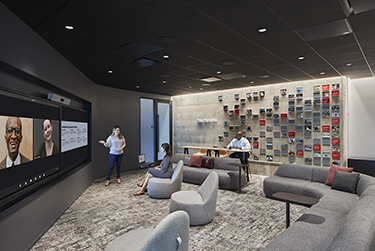|
Subscribe / Renew |
|
|
Contact Us |
|
| ► Subscribe to our Free Weekly Newsletter | |
| home | Welcome, sign in or click here to subscribe. | login |
Architecture & Engineering
| |
 |
February 24, 2022
Redefining offices to inspire confidence
Gensler

Jensen
|
This is an exciting time for innovation in our industry. While we were navigating the restrictions on in-person work and social gatherings, we discovered valuable tools and learned behaviors that enabled us to continue to work, create, collaborate, and engage with others, regardless of where we’re sitting. These tools and skills will launch us forward as we work and collaborate with a more inclusive and global perspective.
The urban core is slowly coming back to life as workers gradually return to the office. While many organizations are embracing permanent remote work options, surveys show that space does matter and the workplace isn’t going anywhere, though the role of the office building, and the workplace inside, will continue to evolve. The office must inspire confidence and provide meaningful experiences that can’t be found at home, as well as address the new health and wellness priorities of the occupants. The integration of digital and physical solutions is essential to fully deliver on these expectations.
DESIGN AND TECHNOLOGY
Our firm, like many others, seamlessly transitioned to working from home, literally overnight, due in large part to our ability to think creatively, be flexible, and establish a connected virtual community. Architects and designers had already embraced digital tools to design and document more efficiently and effectively. New technology and software platforms supporting greater collaboration and more sophisticated design solutions helped us work smarter over the past two years and will continue to be used going forward.
We’re leveraging computational design software to carry out test fits and yield studies with real-time participation and feedback from clients, conducted in a simulated, data-rich environment where we can envision, implement, and evaluate the implications of design decisions instantly. This rapid iteration with greater accuracy, provides more time for the human-driven creativity needed to achieve a unique, site-specific, sustainable design solution. Building developers and owners are able to launch projects faster where speed to market means greater value.
Teams are also using digitally enhanced visualization and virtual white boards as design and communication tools, as well as shared models and documents that provide efficient construction documentation — reducing errors and construction time. And now, more important than ever, is the use of digital tools to track embedded carbon and environmental sustainability.
All these tools can affect positive change and create efficiency in how we collaborate globally to design, construct, and deliver unique, market-driven, sustainable buildings.
Because we work so closely as teams — both internally and with our external partners — we adapted very well to a more virtual mode of collaboration, while others still struggle with the shift. I believe this is unique to us as an industry. We’ve taken these new learned habits, software and work styles, and are translating this into design for the benefit of our clients’ real estate, IT and infrastructure, culture, and health and wellness.
CONNECTED COMPANY CULTURE
Technology has played a crucial role in bridging the physical gap between us from a social perspective throughout this pandemic. It’s not easy to maintain a strong company culture when your employees are scattered across the city, state, or globe. Digital tools and platforms provide opportunities for employees to continue to interact daily with their colleagues and clients. While in-person engagement will always be the most ideal and authentic means of collaboration and connection, we must continue to provide an equitable experience for our teams, whether in-person or virtual.
Investing in improved digital connectivity and increased technological capability within the office makes for seamless experiences for distributed teams that work-from-anywhere. Shared virtual white boards such as Miro provide collaboration in real time for in-person and virtual team members. We’ll continue using whatever our favorite modes of connecting are — Zoom, Teams, etc. — supported by refined video call capabilities, complete with optimal lighting, acoustics, and individual cameras and microphones for all participants. Until we master the use of hologram interactions, we can create an inclusive workplace experience for hybrid work if we have the right tools.
As we continue to perfect our new reality of hybrid environments and work styles, I’m confident that we’ll see a positive impact on the strength and health of our downtown core in alignment with a more gradual increase in employees spending time working in the office and engaging in the community.
We’ve learned how resilient we really are — able to not only weather challenging times but to learn and thrive! Our resilience is anchored by our flexibility. No matter where we are or how we choose to work, the office must bring people, place, and technology together in a way that’s more equitable, engaging, and effective than what we’ve had before.
Kristin Jensen is principal and co-managing director of the Seattle office of Gensler. She has experience managing commercial development projects in the Northwest region — from suburban office parks, to hotels, to urban infill offices and mixed-use.
Other Stories:
- Meet Solera: where mixed-income meets mixed-use meets family time
- The benefits of implementing BIM coordination
- The evolution of hyper-local community spaces
- Holistic Heroes: Lighting designers use efficiency and modeling
- A new perspective on structural fire safety is here
- Reimagining the middle school experience, even before the pandemic



